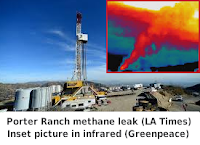Except for a mildly unpleasant aroma (due to an additive called mercaptan) a methane leak, which is the largest constituent of natural gas, is far more harmful to our climate than an oil spill. Unlike the pyrotechnics or black gooey mess that are often associated with an oil spill, a methane leak is invisible. The leak may not be discernible to the naked eye, but it is nonetheless highly destructive to both the earth’s climate and human health. The fact that it cannot be seen does not make it innocuous. The Porter Ranch leak is more serious than any of the 34 major oil spills that took place in North America last year.
Although it has not garnered the same attention, the leak is highly reminiscent of the BP oil spill in the Gulf of Mexico in 2010. So far, 2,300 homes have been evacuated and 1,500 other families are being relocated. The crisis prompted California governor Gerry Brown to issue a state-of-emergency declaration.
Carbon is the best known greenhouse gas, it gets the most press because it represents the largest share of climate pollution. However carbon is a relative lightweight compared to methane when it comes to trapping heat. Over a 100-year period, methane causes 28 times as much warming as carbon dioxide and over a 20 year time span, methane is 84 times as potent as CO2. Methane is responsible for ten percent of US greenhouse gas emissions.
While methane leaks are common at drilling sites, this one is a monster. It is spewing methane at a rate of 40 to 64 tons per hour. The EDF has compared the daily emissions coming out of the Porter Ranch leak to six coal fired power plants or 4.7 million cars. So far around 90,000 metric tons of methane have seeped from the SoCalGas facility and this is expected to continue for many more weeks.
According to Robert Howarth, a professor of ecology and environmental biology at Cornell University and an expert in the impacts of greenhouse gas emissions, the Porter Ranch leak will likely add 5 percent to the total amount of methane released by the entire US oil and gas industry.
Methane is not only destructive to the climate, it is a serious health risk for people. In addition to being highly flammable, methane fumes are dangerous to inhale. Other compounds such as hydrogen sulfide and benzene, have also been detected in the air and they are also injurious to human health. An attorney working on behalf of one thousand local residents says that there are short term effects from the leak including bleeding eyes and gums to long term effects like cancer and death. A class action filing alleges that SoCalGas and its parent company “negligently failed to construct, operate, and maintain” the storage facility.
California Governor Jerry Brown has ordered SoCalGas to pay to mitigate the leak, however, the issue is far deeper than this one event or the costs that it will incur. This leak may help to divest methane of its false persona as a green alternative to coal and oil.
Although the EPA is working on reigning in methane emissions, the Porter Ranch incident points to the wider issue of natural gas extraction. Amy Townsend-Small, a University of Cincinnati professor who’s studied methane emissions from the natural gas industry, said the size of the leak is staggering. “It’s a perfect example of how we can work on decreasing emissions from individual wells, but there’s going to be catastrophic events…and that can change everything,” she said.
This is certainly not the only time that we have seen methane leaks at such facilities. There are about 400 other storage wells like the Aliso Canyon. The Porter Ranch disaster shows just how destructive natural gas extraction can be.
“This event is a watershed moment both because it drives home for the general public the fact that these kinds of problems can and do exist, and hopefully it drives home for the industry that a business-as-usual approach is no longer tenable,” Mark Brownstein, vice president of the climate and energy program at the Environmental Defense Fund (EDF) said.There is a lot of talk about the importance of using natural gas to help wean America off of oil, but the Porter Ranch disaster proves that fracking, touted by some as a more environmentally sound alternative, is anything but safe.
“I think this opens the door to a larger conversation: the fact that this gas is used to meet the peaking electricity demands,” said Timothy O’Connor, a director with EDF. Regulators need to look at “the role of natural gas for meeting peak electricity demand and how we reduce that role.”
Rather than hail natural gas as an important source of cleaner energy we need to acknowledge that it is just another fossil fuel that must be kept in the ground.
Source: Global Warming is Real
Related
Jurisdictions Across the US are Saying "No" to Fracking
The Myth that Fracked Gas is a Bridge Fuel
Fracking Contaminates Drinking Water
Natural Gas Versus Renewable Energy
Fracking and Earthquakes go Together like Sodom and Gomorrah
Obama Begins to Reign-in Methane Emissions from Fracking
Leaking Methane Associated with Fracking
Natural Gas Will Not Slow Climate Change and it Will Impede the Growth of Renewables
Natural Gas (Methane) is Not Clean Energy
Video - Methane is a Potent Greenhouse Gas
Whats the Fracking Problem
Natural Gas Explosions Highlight Safety Concerns

0 comments:
Post a Comment